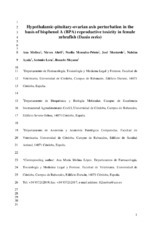Hypothalamic-pituitary-ovarian axis perturbation in the basis of bisphenol A (BPA) reproductive toxicity in female zebrafish (Danio rerio)
Autor
Molina López, Ana María
Abril, Nieves
Morales-Prieto, N.
García-Monterde, J.
Ayala-Soldado, Nahúm
Lora-Benítez, Antonio Jesús
Moyano Salvago, M. Rosario
Editor
ElsevierFecha
2018Materia
Endocrine-disrupting chemicalFish
Adeno-hypophysis
Cyp19b
Gonadotroph cell
METS:
Mostrar el registro METSPREMIS:
Mostrar el registro PREMISMetadatos
Mostrar el registro completo del ítemResumen
Thousands of safety-related studies have been published on bisphenol A (BPA), an ubiquitous environmental pollutant with estrogenic activity and many other potential biological effects. In recent years, BPA exposure has been shown to cause anovulation and infertility through irreversible alteration of the hypothalamic-pituitary-gonadal axis in several organisms, including fish and mammals. Recently, the European Chemical Agency classified BPA as a “substance of very high concern” because of its endocrine-disrupting properties, which have serious effects on human health. Given the risk of exposure to BPA as a pollutant in the environment, food, and drinking water, the objective of our study was to assess the effects of this compound on the adeno-hypophysis by means of a histopathological and morphometric study of the gonadotroph cells. In addition, using quantitative real-time PCR (qRT-PCR) assays, we analyzed the changes in the expression of Cyp19b (an aromatase gene). Zebrafish were randomly distributed into five groups: a control group and 4 treated groups which were exposed to different BPA concentrations (1, 10, 100 and 1000 μg/L). The effects of the different doses on Cyp19b mRNA molecules followed a non-monotonic curve, with the 1 and 1000 μg/L doses causing dramatic decreases in the number of Cyp19b transcripts while the doses of 10 and 100 μg/L caused important increases. The consequences might be deregulation of gonadotropic hormones causing degeneration of gonadotropic cells, as observed in BPA treated animals. This is the first study in which the gonadotroph cells have been evaluated using histomor- phological endpoints after BPA exposure in zebrafish

